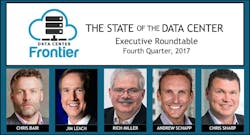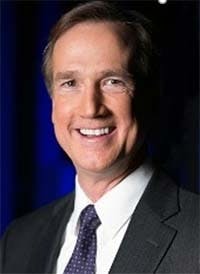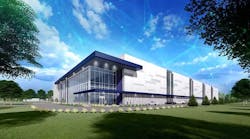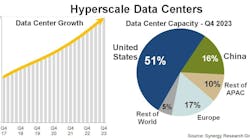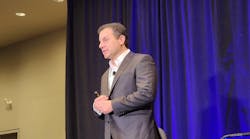Welcome to our ninth Data Center Executive Roundtable, a quarterly feature showcasing the insights of thought leaders on the state of the data center industry, and where it is headed. In our Fourth Quarter 2017 roundtable, we will examine four topics: Key data center trends for 2018, the state of the wholesale data center business, the evolution of data center geography and key markets, and the impact of growing investment in the data center sector.
Here’s a look at our distinguished panel:
- Chris Sharp, the Chief Technology Officer of Digital Realty, the world’s largest provider of data centers and technical real estate. Chris has deep knowledge of the data center sector from his 20 years of experience, including leadership positions with Equinix, Qwest and MCI/Verizon.
- Jim Leach, the Vice President Marketing at RagingWire Data Centers. Leach is the overall marketing leader responsible for a data center portfolio of 1.5 million square feet and 113 megawatts of critical power in the United States.
- Chris Bair, Vice-President of Sales and Marketing for the data center division at Iron Mountain. Prior to Iron Mountain, Chris was SVP of Sales at CoreSite during the company’s successful NYSE IPO, and also worked with Sungard Availability and Inflow.
- Andrew Schaap, CEO of Aligned Energy, is responsible for business growth for its data center and build-to-scale solutions. Prior to joining Aligned Energy, Andrew held numerous leadership positions over an 11-year period with Digital Realty.
The conversation is moderated by Rich Miller, the founder and editor of Data Center Frontier. Each day this week we will present a Q&A with these executives on one of our key topics. We begin our discussion by asking our panel about their predictions for 2018.
Data Center Frontier: What is the one trend you believe will be most significant in shaping the data center industry in 2018, and why?
JAMES LEACH, RagingWire Data Centers
James Leach: We see renewable energy becoming a critical element in data center colocation in 2018.
For the last few years, data center companies have been ‘”talking the talk” when it comes to renewables. In 2018, look for the leading data center companies to “walk the walk” and roll out affordable renewable energy options as part of their colocation offerings.
In the past, we saw companies buying Renewable Energy Credits (RECs) to give them the right to say that they were using renewables, when in fact they were using traditional, mostly carbon-based energy supplies. A few hyperscale cloud companies started installing their own solar farms, but leaving out the local utility was problematic to guarantee supply, especially on cloudy days.
In 2018, expect data center companies and energy utilities to partner to deliver true renewable energy options. The utilities like working with data center companies because data centers require a predictable amount of energy and offer economies of scale. Data center companies like working with power utilities because utilities are experts in reliable energy transmission and they know how to work with regulators to establish contracts, service levels, and pricing.
CHRIS SHARP, Digital Realty
Chris Sharp: I think data and compute proximity, and the effect they have on the data supply chain, is the most interesting dynamic in the industry today. While it may be something of a sleeper in terms of issues that are really driving change, the ability to understand its criticality will really separate the winners from the losers in 2018. Enterprises’ dependence on data to derive actionable insights is growing. Their success there is determined to a large degree by their ability to find providers who can help them put them as close together as possible, so that performance, availability and security are all assured, regardless of the scale.
I think 2018 is also the year of SaaS because there’s so much demand for services and there’s so many tailor-made SaaS applications that are entrenched in solving their unique business problems. It’s less about how much compute and storage you have, and more about your SaaS application and how your customers consume it.
How SaaS is consumed is changing, and how that change is occurring is critical. SaaS interconnectivity is much more complicated to do privately than it is over the public Internet, but the Internet degrades performance and security, making SaaS unusable. If you don’t have the ability to normalize that consumption, using layer two for compute and storage and layer three for application delivery, you’ll be left behind.
ANDREW SCHAAP, CEO of Aligned Energy
Andrew Schaap: As our global economy continues to accelerate, its sustained success depends on the ability for all businesses to be able to deploy mission critical applications in a highly secure environment while having the flexibility to expand data center capacity seamlessly and without disruption.
This year, we believe the most significant trend shaping our industry will be how enterprise companies and large web scalers identify ways to future-proof their entire IT stack. They are going to demand data center ecosystems that balance top-tier security with business and technical flexibility as well as the latitude to execute their business plan, even if they don’t have a clear crystal ball of what it will look like three, five, or 10 years out.
Additionally, there is an uncertainty around densities and applications. We’re seeing clients that want flexibility not only in their contractual environments but also in densities, so that when they hit their 2-3 year IT refresh cycle, they have a partner that can work with them on providing a dynamic floor versus a static floor.
At Aligned Energy, we don’t expect our customers to predict their business needs, capacity requirements or rack densities years in advance. So whether you are are a large-scale cloud provider or an enterprise of any size, our unique model and technology allows us to scale with our customers’ current and future business needs on demand, which reduces stranded capacity and unnecessary expenditures for clients. This environmental agility is further integrated within our infrastructure, which accommodates variable power densities of up to 50kW per rack.
2018 will be all about establishing a data center environment that is adaptable to client needs, reliable, flexible, secure and efficient.
CHRIS BAIR, Iron Mountain
Chris Bair: The Cloud continues to disrupt and drive data storage outside of internal enterprise data centers. Enterprise and public sector customers are continuing to shift load from legacy (and discontinue large investments in new facilities with 20-year life cycles). The rapid change in IT infrastructure makes 20-year bets on internal facilities very difficult for most users.
NEXT: What’s the outlook for the wholesale data center business?
Keep pace with the fact-moving world of data centers and cloud computing by following us on Twitter and Facebook, connecting with me on LinkedIn, and signing up for our weekly newspaper using the form below:
